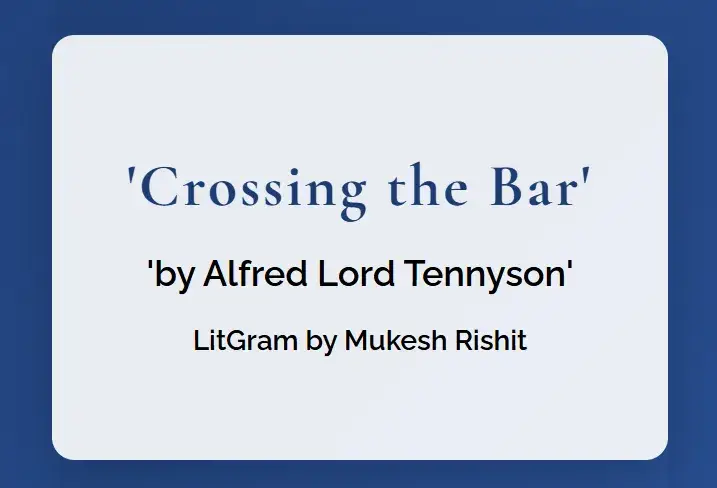Introduction to “Crossing the Bar”
“Crossing the Bar” is one of Alfred Lord Tennyson’s most famous poems, written in 1889. This piece serves as a metaphor for death, using maritime imagery to explore the transition from life to afterlife. In this analysis, we’ll break down the poem line by line, exploring its rich symbolism and profound meaning.
The Poem’s Structure and Form
Before diving into the line-by-line analysis, let’s examine the structure of “Crossing the Bar”:
- Four stanzas of four lines each (quatrains)
- Alternating rhyme scheme (ABAB)
- Mixture of iambic and trochaic meter
This structure contributes to the poem’s musical quality and sense of movement, mirroring the ebb and flow of the sea.
Line-by-Line Analysis
Stanza 1
Sunset and evening star,
And one clear call for me!
And may there be no moaning of the bar,
When I put out to sea,
Key Points:
- “Sunset” symbolizes the end of life
- “Evening star” represents hope or guidance
- “Clear call” suggests a peaceful, expected death
- “Moaning of the bar” refers to the sound of waves over a sandbar, symbolizing a difficult passage
Stanza 2
But such a tide as moving seems asleep,
Too full for sound and foam,
When that which drew from out the boundless deep
Turns again home.
Key Points:
- The tide metaphor continues, representing the journey of life
- “Moving seems asleep” and “Too full for sound and foam” imply a calm, peaceful transition
- “Boundless deep” could represent the source of life or the universe
- “Turns again home” suggests returning to a spiritual origin
Stanza 3
Twilight and evening bell,
And after that the dark!
And may there be no sadness of farewell,
When I embark;
Key Points:
- “Twilight” and “evening bell” further the theme of life’s end
- “The dark” represents the unknown of death
- The speaker hopes for no “sadness of farewell,” preferring a peaceful departure
Stanza 4
For tho’ from out our bourne of Time and Place
The flood may bear me far,
I hope to see my Pilot face to face
When I have crost the bar.
Key Points:
- “Bourne of Time and Place” refers to the limits of earthly existence
- “The flood” represents death carrying the speaker into the afterlife
- “Pilot” is likely a reference to God or a divine guide
- “Crost the bar” means passing from life to death
Themes and Symbolism in “Crossing the Bar”
Maritime Metaphors
Tennyson uses sea imagery throughout the poem to represent the journey from life to death. The “bar” refers to a sandbar, a challenging obstacle for ships to cross, symbolizing the barrier between life and death.
Acceptance of Death
The poem’s tone is one of calm acceptance. Tennyson portrays death not as something to be feared, but as a peaceful transition, like a ship sailing out to sea.
Spiritual Journey
The reference to the “Pilot” in the final stanza suggests a belief in an afterlife and a divine presence guiding the soul’s journey.
Literary Devices in “Crossing the Bar”
- Metaphor: The entire poem is an extended metaphor, comparing death to a sea voyage.
- Symbolism: Various elements symbolize aspects of life and death (e.g., sunset, evening star, tide).
- Alliteration: “such a tide as moving seems asleep”
- Personification: The tide is described as if it were alive.
Conclusion: The Lasting Impact of “Crossing the Bar”
“Crossing the Bar” remains one of Tennyson’s most beloved poems, admired for its serene approach to death and masterful use of maritime imagery. Its themes of acceptance, hope, and spiritual journey continue to resonate with readers, making it a timeless piece of literature that offers comfort and contemplation on the subject of mortality.
By exploring death through the lens of a sea voyage, Tennyson creates a powerful and accessible metaphor that has helped generations of readers grapple with the concept of life’s end. The poem’s enduring popularity is a testament to its ability to address a universal human experience with grace and profound insight.
FAQs
1. Why did Tennyson write “Crossing the Bar”?
Tennyson wrote this poem towards the end of his life, reflecting his thoughts on the transition from life to death. It serves as a meditation on mortality and the acceptance of life’s inevitable end.
2. How does the structure of the poem enhance its meaning?
The alternating rhyme scheme and the lyrical quality of the poem mirror the rhythmic motion of the sea, reinforcing the theme of life’s continuous journey.
3. What does the “Pilot” symbolize in the poem?
The “Pilot” likely symbolizes God or a divine guide who will navigate the speaker through the afterlife. This figure represents hope and faith in transcendence.
4. How does Tennyson’s use of maritime imagery affect the tone of the poem?
Maritime imagery imbues the poem with a sense of calm and serenity, framing death as a natural journey rather than something to fear.
5. What is the significance of the poem’s last line, “When I have crost the bar”?
The last line signifies the completion of life’s journey and the transition into the afterlife. It encapsulates the poem’s central theme of peaceful acceptance of death.
For more in-depth analyses of Tennyson’s works, you might want to check out The Lady of Shalott and In Memoriam A.H.H.. These pieces further illustrate Tennyson’s masterful use of symbolism and contemplation on life and death.


